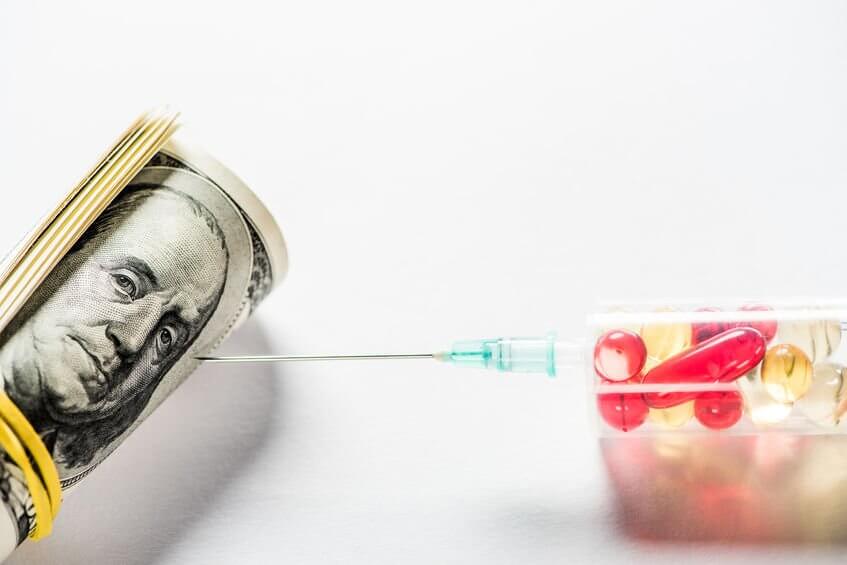
When someone tells me they “can’t” afford a $47 challenge, much less the thousand bucks for a custom program, I always wanna ask:
How much is your current situation of being fat, sick, and on medications costing you?
Let’s take a look at some numbers, starting with health insurance.
As we know, there are a TON of factors that go in to what determines both what you pay and what you get for health insurance. (Not having health insurance costs you, too, in the form of a tax penalty, unless that law’s been changed.)
The average monthly cost of health insurance (including employer and employee contributions) for one person in 2018 was $574 per month. Family coverage averaged $1,634.1
And that doesn’t include what you pay if you actually have to USE that health insurance!
If you do use it, and you’re fortunate, it covers, all your expenses.
If not, you could have a deductible of thousands of dollars, plus end up with ongoing expenses for medication.
Depending on what the medication is, how much you need, and how much of the expense your insurance covers, you could pay anywhere from a few dollars to thousands of dollars per month.
Let’s take diabetes as an example.
According to a report commissioned by the American Diabetes Association, the total costs of diagnosed diabetes have risen to $327 billion in 2017 from $245 billion in 2012, when the cost was last examined.
That’s 26% increase in five years!
That estimated $327 billion includes $237 billion in direct medical costs and $90 billion in reduced productivity.
Here’s a more exact breakdown.
- hospital inpatient care (30% of the total medical cost),
- prescription medications to treat complications of diabetes (30%),
- anti-diabetic agents and diabetes supplies (15%), and
- physician office visits (13%).
People with diagnosed diabetes (meaning not counting all the people who have it and don’t realize it) pay an average of $16,752 per year in medical expenses, of which about $9,601 is attributed to the diabetes.
And people with diagnosed diabetes have medical expenditures approximately 2.3 times higher than what they’d have with no diabetes, according to the study.
For the cost categories analyzed in the study, care for people with diagnosed diabetes accounts for 1 in 4 healthcare dollars in the U.S., and more than half of that expenditure is “directly attributable to diabetes.”
Indirect costs include:
- missing work ($3.3 billion),
- reduced productivity while at work ($26.9 billion) for the employed population,
- reduced productivity for those not in the labor force ($2.3 billion),
- inability to work as a result of disease-related disability ($37.5 billion), and
- lost productive capacity due to early death ($19.9 billion).
Are you freaked out yet?
And it only gets worse! Look at this next found of numbers from this study:
- Most of the cost for diabetes care in the U.S., 67.3%, is provided by government insurance (including Medicare, Medicaid, and the military). The rest is paid for by private insurance (30.7%) or by the uninsured (2%).
- People with diabetes who do not have health insurance have 60% fewer physician office visits and are prescribed 52% fewer medications than people with insurance coverage—but they also have 168% more emergency department visits than people who have insurance.
- Total per-capita healthcare expenditures are higher among men than women ($10,060 vs. $9,110).
- Total per-capita healthcare expenditures are lower among Hispanics ($8,050) and higher among non-Hispanic blacks ($10,470) and among non-Hispanic whites ($9,800).
- Compared to non-Hispanic whites, per capita hospital inpatient costs are 23% higher among non-Hispanic blacks and 29% lower among Hispanics. Non-Hispanic blacks also have 65% more emergency department visits than the population with diabetes as a whole.
- Among states, California has the largest population with diabetes and thus the highest costs, at $39.47 billion. Texas ($25.60 billion), Florida ($24.80 billion), and New York ($21.23 billion) round out the top four states in terms of total annual cost.
And all this is from just ONE disease! There are countless others out there, along with other problems caused by poor eating and lifestyle habits.
After reading all that, if you still think $47 to take your life back, and either AVOID paying thousands a year, or be able to reduce what you pay, I don’t know what to tell you.
But if, after reading that, you realize $47 is a bargain, use the button below to get on the next 10 Pound Takedown, and take your life back!
